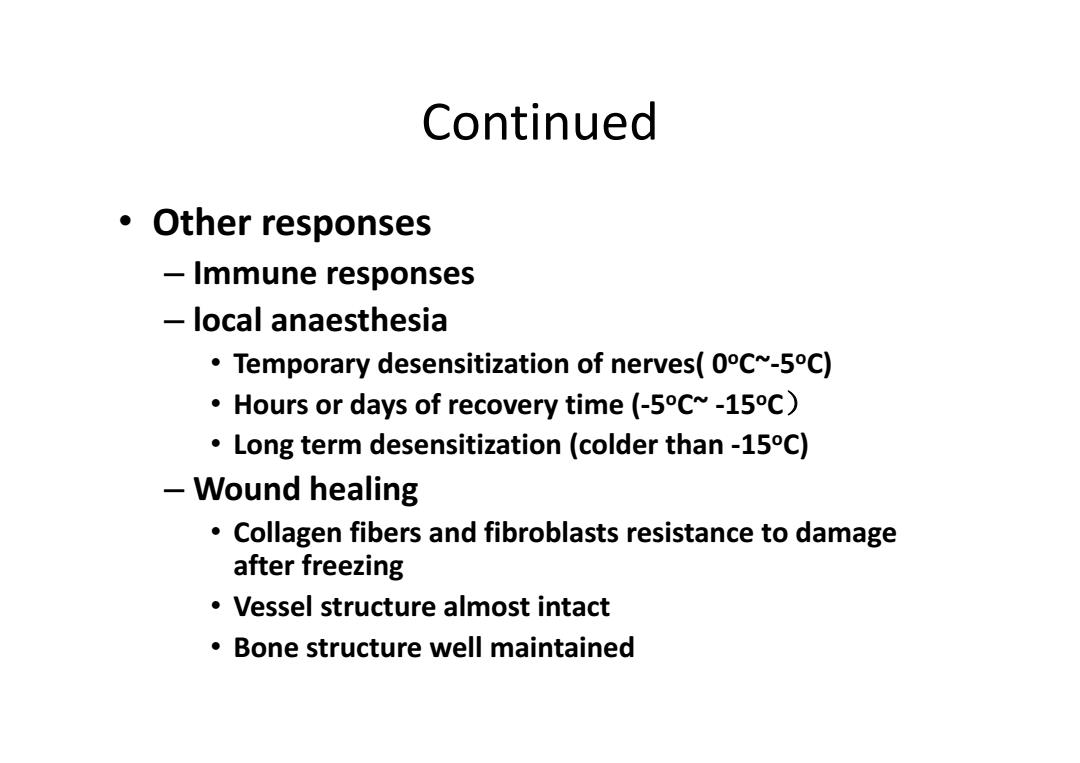
Lecture 26: Cryosurgery
Lecture 26: Cryosurgery

Cryosurgery:ablation of undesired tissues Tumor(benign or malignant) wart,acne scars(疣,瘤,痣,粉刺) cysts(囊肿) Others
• Cryosurgery: ablation of undesired tissues – Tumor( benign or malignant) – wart, acne scars(疣,瘤,痣, 粉刺) – cysts (囊肿) – Others

Cryosurgery devices ·Cotton-tip 2004 D avid Klemm ·Spray ·Cryoprobes Touchable inserted
Cryosurgery devices • Cotton‐tip • Spray • Cryoprobes – Touchable – inserted

Coolants used for Cryosurgery ·Liquid N2(-196C) ·Liquid N20(-98C) ·Argon(-140°C)
Coolants used for Cryosurgery • Liquid N2 (‐196oC) • Liquid N2O (‐98oC) • Argon (‐140oC)

A typical process of cryosurgery (movie)
• A typical process of cryosurgery (movie)

Freezing Responses during Cryosurgery ·Direct cell injury Ice crystals -solutes effect -thermal stresses ·Vascular damage Blood complete shut down at about 1-3C -Reperfusion ·Apoptosis Programmed cell death
Freezing Responses during Cryosurgery • Direct cell injury – Ice crystals – solutes effect – thermal stresses • Vascular damage – Blood complete shut down at about 1‐3oC – Reperfusion • Apoptosis – Programmed cell death

Continued ● Other responses -Immune responses -local anaesthesia Temporary desensitization of nerves(0C~-5C) Hours or days of recovery time (-5C~-15C) Long term desensitization (colder than-15C) -Wound healing Collagen fibers and fibroblasts resistance to damage after freezing Vessel structure almost intact Bone structure well maintained
Continued • Other responses – Immune responses – local anaesthesia • Temporary desensitization of nerves( 0oC~‐5oC) • Hours or days of recovery time (‐5oC~ ‐15oC) • Long term desensitization (colder than ‐15oC) – Wound healing • Collagen fibers and fibroblasts resistance to damage after freezing • Vessel structure almost intact • Bone structure well maintained

Manipulation of the injury/response TABLE 1.LETHAL TEMPERATURES FOR CELLS:EXPERIMENTS IN VIVO WITH SINGE FREEZE-THAW(F-T)CYCLES Lethal Authors Year Cell/tissue temperature F-T cycle Gage et al.30 1966 Osteocytes,bone,dog -2℃ 5 min F-slow T Gage et al.35 1979 Melanocytes,skin,dog -4C 4 min F-slow T Smith and Fraser36 1974 Liver,rat -15℃ 3 min F-fast T Rivoire et al.37 1996 Liver,pig -15C 5 min F-slow T Schmidlin et al.38 2001 Kidney,pig -16.1℃ 15 min F-slow T LeFebre and Folke16 1975 Cheek pouch,hamster -18℃ 1 min F-fast T Chosy et al.39 1998 Kidney,pig -19.4℃ 5 min-T? Dow and Waterhouse40 1970 Prostate,dog -20℃ seconds F-slow T Gage et al.41 1982 Skin,dog -40℃ 3 min F-slow T Yamada and Tsubouchi42 1976 Skin,mouse -40℃ 1 min F-slow T Gage43 1978 Palate,dog -40℃ 3 min F-slow T Neel et al.44 1971 Sarcoma,mouse -60℃ 6 min F-slow T Staren et al.45 1997 Adenocarcinoma -70℃ 7 min F-slow T Cells die in progressively greater numbers as the temperature is lowered.In this table,lethal temperatures expresses the temperature at which all of the cited cells appear to be dead
Manipulation of the injury/response

Other applications of Low temperature in biology and medicine Cardiac cryosurgery and Cryomapping Treatment of myocardial ischemia:stimulation of new blood vessels Inhibition of smooth muscle proliferation Frostbite(very slow freezing of extremeties)
Other applications of Low temperature in biology and medicine • Cardiac cryosurgery and Cryomapping • Treatment of myocardial ischemia: stimulation of new blood vessels • Inhibition of smooth muscle proliferation • Frostbite (very slow freezing of extremeties)

·Adjunctive therapy -anticancer drugs; irradiation;(cooled cells shown increased radio- sensitivity -apoptotic agents or other agents
• Adjunctive therapy – anticancer drugs; – irradiation; (cooled cells shown increased radio‐ sensitivity – apoptotic agents or other agents